NINTH EDITION PERSONALITY Jess Feist Gregory J. Feist Tomi-Ann Roberts

Theories of Personality Jess Feist McNeese State University Gregory J. Feist San Jose State University Tomi-Ann Roberts Colorado College
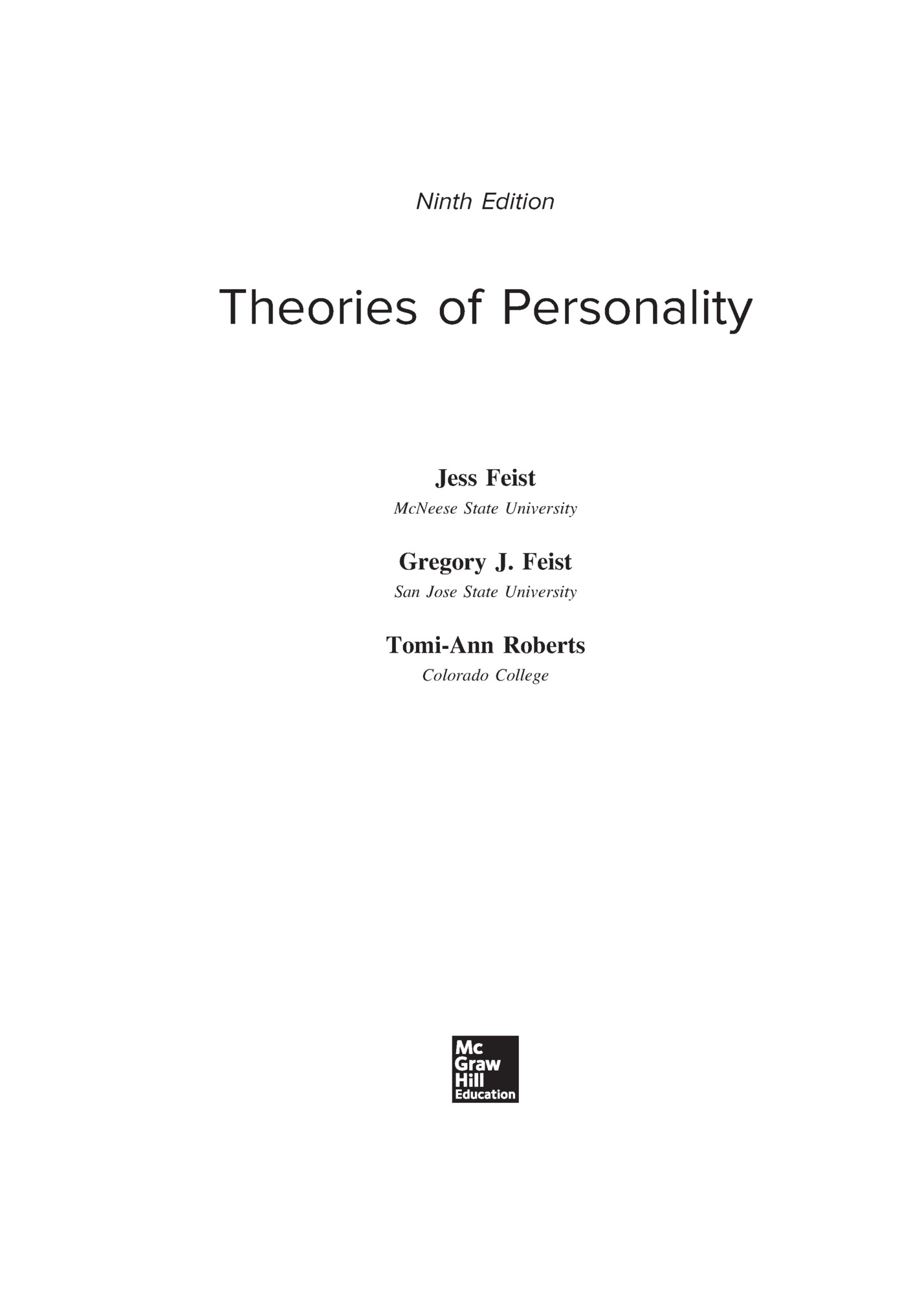
Published by McGraw-Hill Education, 2 Penn Plaza, New York, NY 10121. Copyright © 2018 by McGraw-Hill Education. All rights reserved. Printed in the United States of America. Previous editions © 2013, 2009, and 2006. No part of this publication may be reproduced or distributed in any form or by any means, or stored in a database or retrieval system, without the prior written consent of McGraw-Hill Education, including, but not limited to, in any network or other electronic storage or transmission, or broadcast for distance learning. Some ancillaries, including electronic and print components, may not be available to customers outside the United States. This book is printed on acid-free paper. 1 2 3 4 5 6 7 8 9 LCR 21 20 19 18 17 ISBN: 978-0-07-786192-6 MHID: 0-07-786192-2 Chief Product Officer, SVP Products & Markets: G. Scott Virkler Vice President, General Manager, Products & Markets: Michael Ryan Vice President, Content Design & Delivery: Betsy Whalen Managing Director: David Patterson Brand Manager: Jamie Laferrera Product Developer: Alex Preiss Marketing Manager: Meredith Leo Director, Content Design & Delivery: Terri Schiesl Program Manager: Debra Hash Content Project Managers: Jodi Banowetz; Sandy Wille Buyer: Laura M. Fuller Design: Matt Backhaus Content Licensing Specialists: Lori Slattery Cover Image: ©lightwise/123RF Compositor: Aptara®, Inc. Printer: LSC Communications All credits appearing on page or at the end of the book are considered to be an extension of the copyright page. Library of Congress Cataloging-in-Publication Data Names: Feist, Jess, author. | Feist, Gregory J., author. | Roberts, Tomi-Ann, author. Title: Theories of personality / Jess Feist, McNeese State University, Gregory J. Feist, San Jose State University, Tomi-Ann Roberts, Colorado College. Description: Ninth Edition. | Dubuque : McGraw-Hill Education, [2018] | Revised edition of the authors’ Theories of personality, c2013. | Includes bibliographical references and indexes. Identifiers: LCCN 2016050779 | ISBN 9780077861926 (alk. paper) | ISBN 0077861922 (alk. paper) Subjects: LCSH: Personality—Textbooks. Classification: LCC BF698 .F365 2018 | DDC 155.2—dc23 LC record available at https://lccn.loc.gov/2016050779 The Internet addresses listed in the text were accurate at the time of publication. The inclusion of a website does not indicate an endorsement by the authors or McGraw-Hill Education, and McGraw-Hill Education does not guarantee the accuracy of the information presented at these sites. mheducation.com/highered
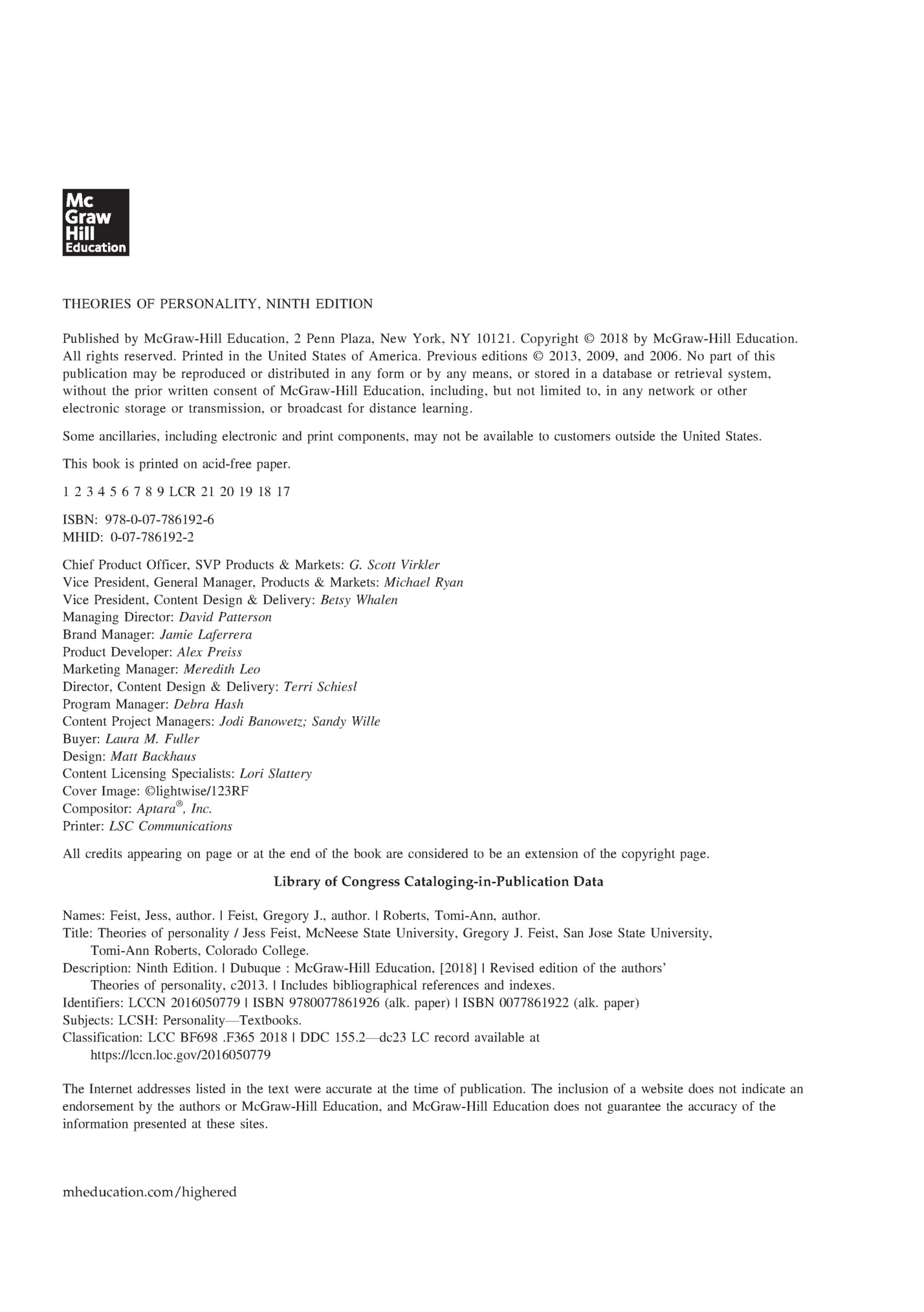
Jess Feist was Professor of Psychology at McNeese State University in Lake Charles, Louisiana from 1964 until his death in 2015. Besides coauthoring Theories of Personality, he coauthored with Linda Brannon, Health Psychology: An Introduction to Behavior and Health. He earned his undergraduate degree from St. Mary of the Plains and graduate degrees from Wichita State University and the University of Kansas. His research interest was in early childhood recollections. Gregory J. Feist is a Professor of Psychology in the Department of Psychology at San Jose State University. He has also taught at the College of William & Mary and University of California, Davis. He received his PhD in personality psychology in 1991 from the University of California at Berkeley and his undergraduate degree in 1985 from the University of Massachusetts– Amherst. He is widely published in the psychology of creativity, the psychology of science, and the development of scientific talent. His recent book, The Psychology of Science and the Origins of the Scientific Mind, was awarded the William James Book Award from the American Psychological Association (APA). He is founding president of the International Society for the Psychology of Science & Technology and founding editor-in-chief of the Journal of Psychology of Science & Technology. His research in creativity has been recognized by an Early Career Award from the Division for Psychology of Aesthetics, Creativity and the Arts (Division 10) of APA, and he is former president of Division 10. Finally, he is co-author of Psychology: Perspectives and Connections (McGraw-Hill) with Erika osenberg. R iii

About the Authors Tomi-Ann Roberts is a Professor of Psychology at Colorado College. She received her PhD in social and personality psychology in 1990 from Stanford University, and her BA in psychology from Smith College in 1985. Her publications in the areas of gender, personality, and emotion psychology i nclude “Objectification Theory,” an original theory that has generated a great deal of research into the causes and consequences of the sexual objectification of girls and women. The first paper she co-authored on this topic is the most cited article in the 35-year history of the journal Psychology of Women Quarterly. She served on the American Psychological Association’s Task Force on the Sexualization of Girls, is coauthor of the Sexualization of Girls and Girlhood: Causes, Consequences and Resistance (2012), and continues to work on empirical research, applied consulting work, and media efforts in this area. In addition to her teaching in both psychology and gender studies at Colorado College, she currently serves on the executive committee of APA’s Division 35, chairs a Task Force on ducating Through Feminist ReE search, and is a certified Laughter Yoga Leader.

PART I Introduction 1 CHAPTER 1 Introduction to Personality PART II Psychodynamic Theories 19 Theory 2 CHAPTER 2 Freud: Psychoanalysis 20 What Is Personality? 3 What Is a Theory? 5 Overview of Psychoanalytic Theory 21 Biography of Sigmund Freud 22 Levels of Mental Life 28 Theory Defined 5 Theory and Its Relatives 5 Philosophy 5 Speculation 6 Hypothesis 6 Taxonomy 7 Why Different Theories? 7 Perspectives in Theories of Personality 7 Psychodynamic Theories 8 Humanistic-Existential Theories 8 Dispositional Theories 8 Biological-Evolutionary Theories 8 Learning-(Social) Cognitive Theories 8 Theorists’ Personalities and Their Theories of Personality 10 What Makes a Theory Useful? 11 Generates Research 12 Is Falsifiable 12 Organizes Data 13 Guides Action 13 Is Internally Consistent 14 Is Parsimonious 14 Dimensions for a Concept of Humanity 14 Research in Personality Theory 16 Unconscious 28 Preconscious 29 Conscious 30 Provinces of the Mind 31 The Id 32 The Ego 33 The Superego 34 Dynamics of Personality 36 Drives 36 Sex 36 Aggression 37 Anxiety 38 Defense Mechanisms 39 Repression 39 Reaction Formation 40 Displacement 40 Fixation 41 Regression 41 Projection 41 Introjection 42 Sublimation 42 Stages of Development 43 Infantile Period 43 Oral Phase 43 v
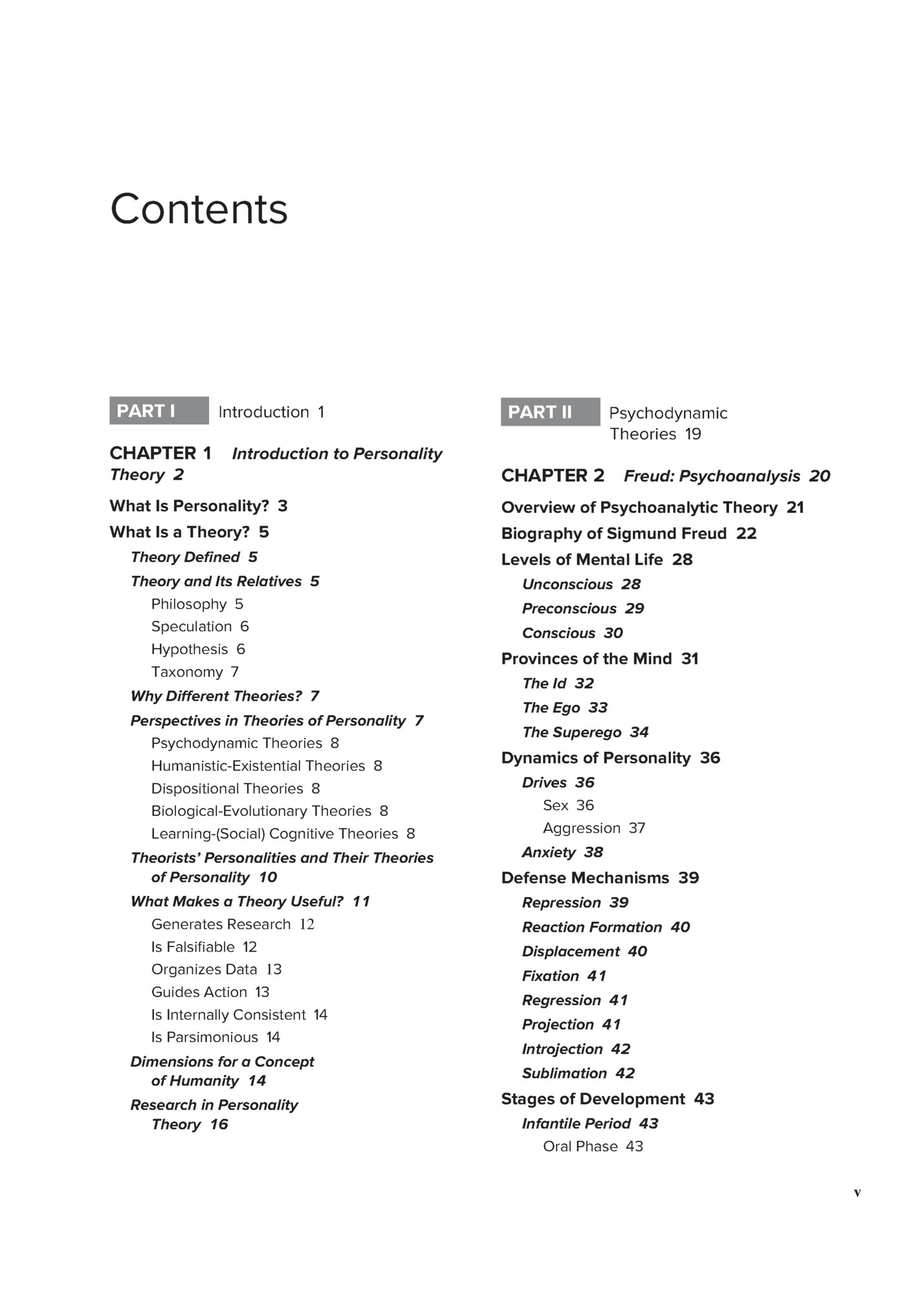
Contents Anal Phase 44 Phallic Phase 45 Male Oedipus Complex 45 Female Oedipus Complex 47 Latency Period 50 Genital Period 50 Maturity 51 Applications of Psychoanalytic Theory 52 Freud’s Early Therapeutic Technique 52 Freud’s Later Therapeutic Technique 53 Dream Analysis 54 Freudian Slips 56 Related Research 57 Unconscious Mental Processing 58 Pleasure and the Id, Inhibition and the Ego 59 Repression, Inhibition, and Defense Mechanisms 60 Research on Dreams 61 Critique of Freud 63 Social Interest 81 Origins of Social Interest 82 Importance of Social Interest 83 Style of Life 84 Creative Power 85 Abnormal Development 85 General Description 86 External Factors in Maladjustment 86 Exaggerated Physical Deficiencies 86 Pampered Style of Life 87 Neglected Style of Life 87 Safeguarding Tendencies 87 Excuses 88 Aggression 88 Withdrawal 89 Masculine Protest 90 Origins of the Masculine Protest 90 Adler, Freud, and the Masculine Protest 90 Applications of Individual Psychology 91 Did Freud Understand Women, Gender, and Sexuality? 63 Family Constellation 91 Was Freud a Scientist? 65 Dreams 94 Concept of Humanity 67 Early Recollections 92 Psychotherapy 95 Related Research 96 CHAPTER 3 Adler: Individual Psychology 70 Overview of Individual Psychology 71 Biography of Alfred Adler 72 Introduction to Adlerian Theory 75 Striving for Success or Superiority 76 The Final Goal 76 The Striving Force as Compensation 77 Striving for Personal Superiority 78 Striving for Success 78 Subjective Perceptions 79 Fictionalism 79 Physical Inferiorities 79 Unity and Self-Consistency of Personality 80 Birth Order Effects 96 Early Recollections and Career Choice 98 Distinguishing Narcissism as Striving for Superiority, versus Self-Esteem as Striving for Success 100 Critique of Adler 101 Concept of Humanity 102 CHAPTER 4 Jung: Analytical Psychology 104 Overview of Analytical Psychology 105 Biography of Carl Jung 106 Levels of the Psyche 110 Conscious 110 Personal Unconscious 111 Organ Dialect 80 Collective Unconscious 111 Conscious and Unconscious 81 Archetypes 112
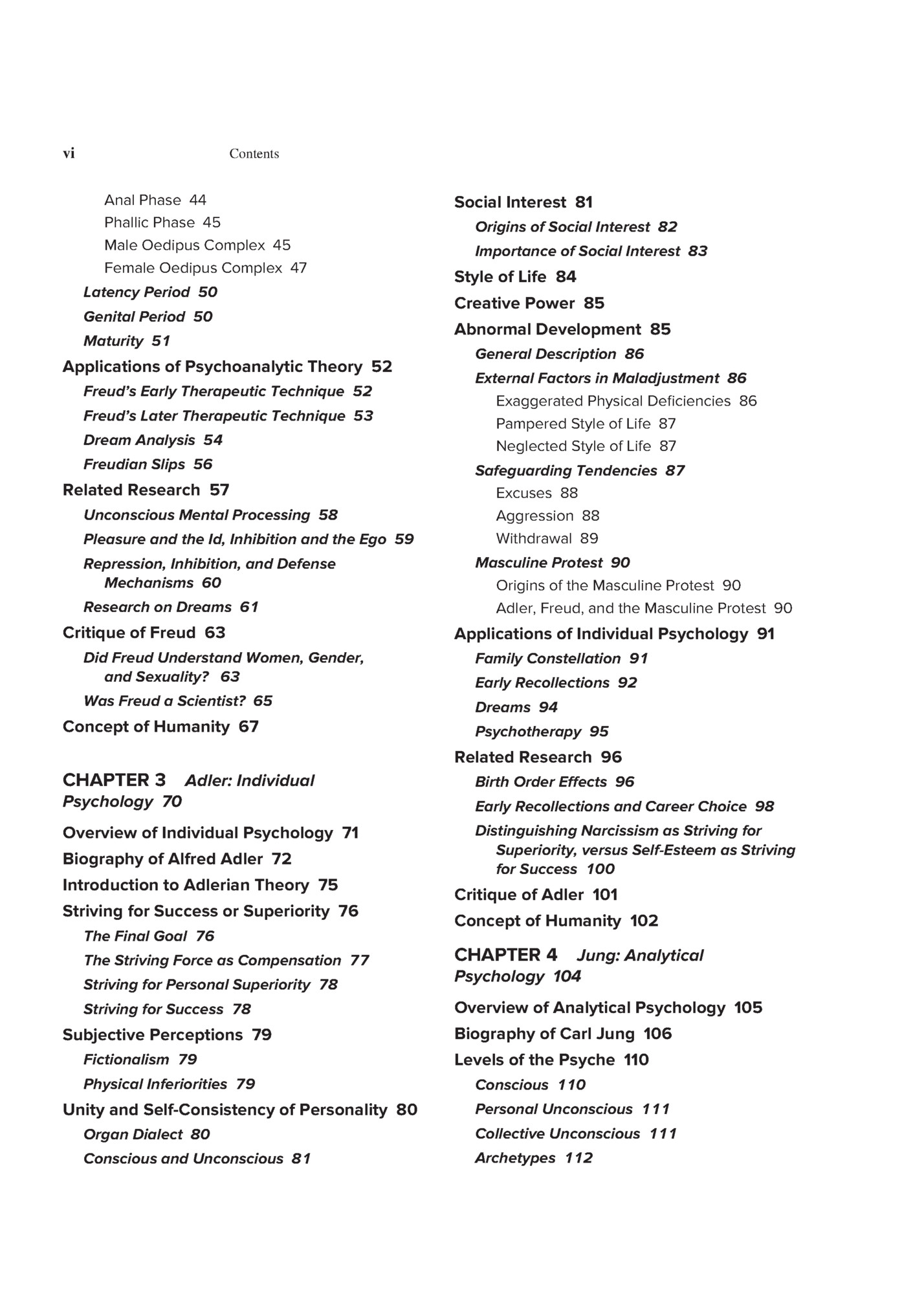
Persona 113 Shadow 114 Anima 115 Animus 116 Great Mother 116 Wise Old Man 117 Hero 117 Self 118 Dynamics of Personality 121 Causality and Teleology 121 Progression and Regression 121 Psychological Types 122 Attitudes 122 Introversion 122 Extraversion 123 Functions 124 Thinking 124 Feeling 124 Sensing 125 Intuiting 125 Development of Personality 127 Stages of Development 127 Childhood 127 Youth 128 Middle Life 128 Old Age 129 Self-Realization 129 Jung’s Methods of Investigation 130 Word Association Test 130 Dream Analysis 131 Active Imagination 133 Psychotherapy 134 Related Research 135 Personality Type and Leadership 135 Personality Type Among Clergy and Churchgoers 136 A Critical Look at the Myers-Briggs Type Indicator (MBTI) 138 Critique of Jung 138 Concept of Humanity 140 vii CHAPTER 5 Klein: Object Relations Theory 142 Overview of Object Relations Theory 143 Biography of Melanie Klein 144 Introduction to Object Relations Theory 146 Psychic Life of the Infant 147 Phantasies 147 Objects 148 Positions 148 Paranoid-Schizoid Position 148 Depressive Position 150 Psychic Defense Mechanisms 150 Introjection 150 Projection 151 Splitting 151 Projective Identification 152 Internalizations 152 Ego 152 Superego 153 Oedipus Complex 154 Female Oedipal Development 154 Male Oedipal Development 155 Later Views on Object Relations 155 Margaret Mahler’s View 156 Heinz Kohut’s View 158 John Bowlby’s Attachment Theory 159 Mary Ainsworth and the Strange Situation 160 Psychotherapy 162 Related Research 162 Childhood Trauma and Adult Object Relations 162 Attachment Theory and Adult Relationships 163 Critique of Object Relations Theory 166 Concept of Humanity 167 CHAPTER 6 Horney: Psychoanalytic Social Theory 170 Overview of Psychoanalytic Social Theory 171
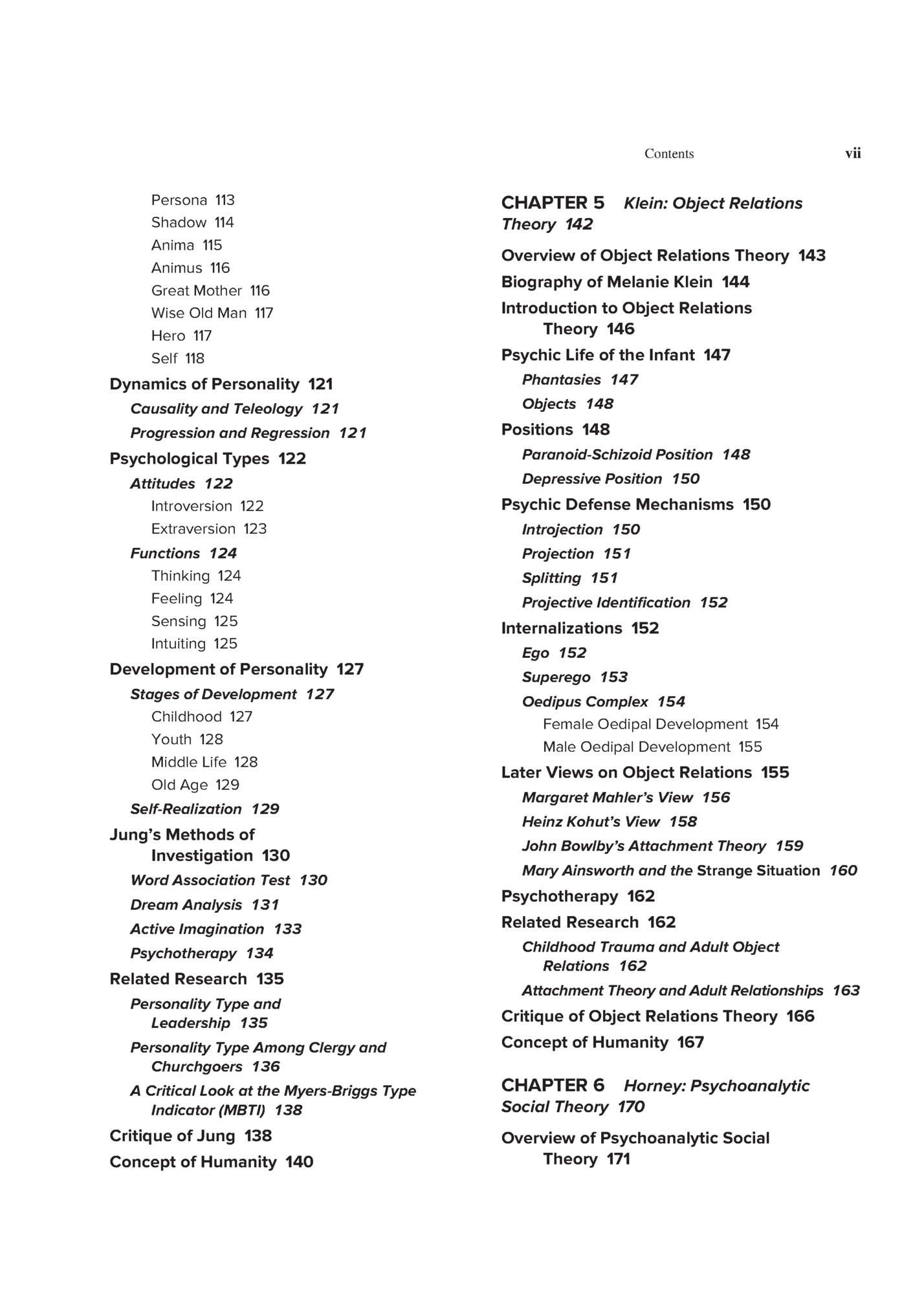
Contents Biography of Karen Horney 172 Introduction to Psychoanalytic Social Theory 174 Horney and Freud Compared 174 The Impact of Culture 174 The Importance of Childhood Experiences 175 Basic Hostility and Basic Anxiety 175 Compulsive Drives 177 Neurotic Needs 177 Neurotic Trends 178 Moving Toward People 180 Moving Against People 180 Moving Away From People 181 Intrapsychic Conflicts 182 The Idealized Self-Image 183 The Neurotic Search for Glory 183 Neurotic Claims 184 Neurotic Pride 185 Self-Hatred 185 Feminine Psychology 186 Psychotherapy 189 Related Research 190 Developing and Validating a New Measure of Horney’s Neurotic Trends 190 Can Neuroticism Ever Be a Good Thing? 191 Critique of Horney 193 Concept of Humanity 194 CHAPTER 7 Erikson: Post-Freudian Theory 196 Overview of Post-Freudian Theory 197 Biography of Erik Erikson 198 The Ego in Post-Freudian Theory 200 Society’s Influence 201 Epigenetic Principle 201 Stages of Psychosocial Development 203 Infancy 205 Oral-Sensory Mode 205 Basic Trust Versus Basic Mistrust 205 Hope: The Basic Strength of Infancy 206 Early Childhood 206 Anal-Urethral-Muscular Mode 206 Autonomy Versus Shame and Doubt 207 Will: The Basic Strength of Early Childhood 207 Play Age 208 Genital-Locomotor Mode 208 Initiative Versus Guilt 208 Purpose: The Basic Strength of the Play Age 209 School Age 209 Latency 209 Industry Versus Inferiority 209 Competence: The Basic Strength of the School Age 210 Adolescence 210 Puberty 210 Identity Versus Identity Confusion 210 Fidelity: The Basic Strength of Adolescence 212 Young Adulthood 212 Genitality 213 Intimacy Versus Isolation 213 Love: The Basic Strength of Young Adulthood 213 Adulthood 214 Procreativity 214 Generativity Versus Stagnation 214 Care: The Basic Strength of Adulthood 215 Old Age 215 Generalized Sensuality 216 Integrity Versus Despair 216 Wisdom: The Basic Strength of Old Age 216 Summary of the Life Cycle 217 Erikson’s Methods of Investigation 218 Anthropological Studies 218 Psychohistory 218 Related Research 221 Ego Identity Status in Adolescents Across Cultures 221 Does Identity Precede Intimacy? 222 Critique of Erikson 223 Concept of Humanity 224
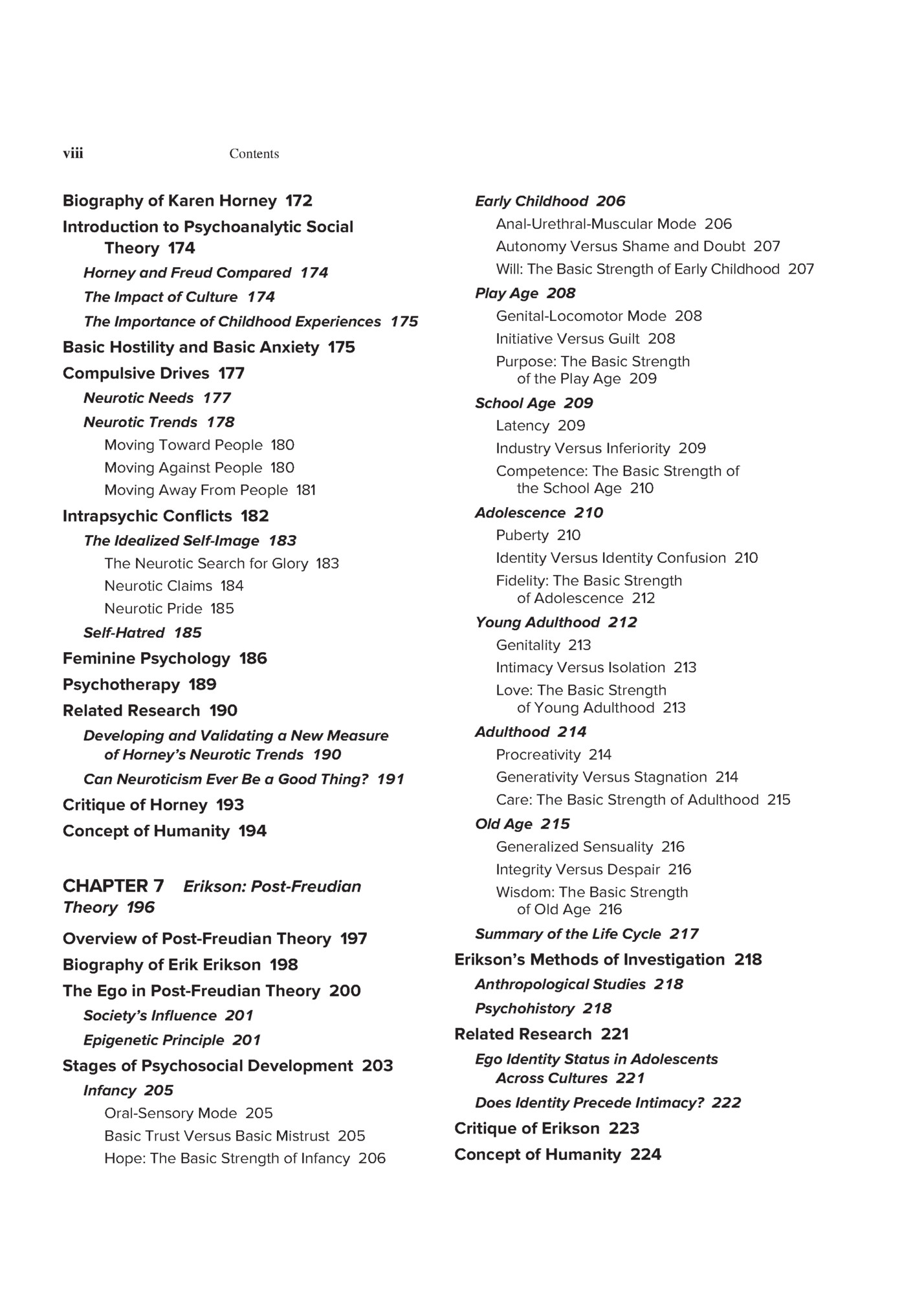
Fleepit Digital © 2021